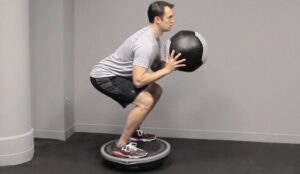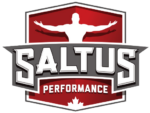INTRODUCTION
At Saltus, one of our mandates is to educate athletes on appropriate training methods and principles. However, several poor training practices have emerged recently on social media that set a poor example for young athletes. Gimmicks aren’t better, better is better. This is the fourth installment in our blog series that highlights ill-advised training practices. If you haven’t checked it out already, read the first three blogs in the series where we cover why agility ladders are a poor tool when training for speed, why altitude masks are one of the worst training tools you can use, and why an over-emphasis on hard conditioning will make you slower.
POOR TRAINING #4: UNSTABLE SURFACES
One of the most misguided ways that speed/power athletes can train is by using unstable surfaces. In a gym setting, unstable surfaces usually come in the form of BOSU balls, exercise balls, and balance boards. Uneducated athletes and trainers will often perform weight training exercises such as squats, lunges, deadlifting and even pressing variations while standing or kneeling on these unstable surfaces. In a lot of cases, the athlete will even perform the exercises unilaterally (i.e. standing on one leg) in order to further decrease stability during the exercise. The thought process behind doing this is that the unstable surface creates a more “functional exercise” by throwing the athlete off-balance and forces the athlete to increase the activation of “core” and stabilizer muscles. However, as we will outline below, this is one of the worst ways to train when it comes to strength and power development.
THE IMPORTANCE OF EXTERNAL LOAD AND INTENSITY
In order for an athlete to become stronger, faster, or more powerful, an athlete must progress in intensity. In strength & conditioning, “intensity” is defined as a percentage of maximum load or velocity. Therefore, for a workout to be classified as “high-intensity”, the work you do needs to be upwards of 95-100% of the 1RM in a particular lift, or 95-100% of the maximum velocity you can sprint. Anything outside of these percentages is, by definition, not high-intensity. Intensity does NOT equate to ratings of perceived exertion (RPE) during a particular exercise (how difficult the exercise feels), or outward signs of fatigue.
Therefore, for an athlete to become stronger in the weight room, he or she must successfully lift an external load (i.e. weight) that is heavier than what they have ever lifted before, or in the case of power development, they must perform the exercise with a faster rate of force development (RFD) – that is, more powerfully – than ever before. Likewise, if an athlete is training for speed, they must sprint at a velocity that is faster than they have ever run before. This ensures that the human organism is appropriately stressed, and has a reason to positively adapt and supercompensate. Conversely, if the exercise does not meet a minimum threshold of intensity, the human organism does not have a reason to adapt and the athlete will not improve.
HOW UNSTABLE SURFACES HINDER FORCE PRODUCTION
Unstable surfaces greatly decrease the level of intensity that an athlete can train at by decreasing the external load that an athlete can lift, and this has overwhelming support when doing a quick search through strength and conditioning literature. Behm et al (2002) found that force production decreased as much as 70% when using an unstable surface compared to a stable surface, and Kohler et al (2010) found little supporting evidence for the use of unstable surfaces or loads due to the decreases in force production. Chulvi-Medrano et al (2010) found that the use of instability devices does not increase performance during the deadlift. McBride et al (2010) found that unstable surfaces decreased the amount of load used in squatting exercises, and recommended against their use due to the potential to limit physiological adaptation. Not limited to the lower body, Saeterbakken & Fimland (2013) found an inferior effect of unstable surfaces on muscle activation and strength during bench pressing. This list of refuting evidence against unstable surface training goes on and on.
OPPORTUNITY COST AND RISK
Another important consideration when choosing which exercises to use with an athlete is the opportunity cost; how beneficial is the exercise, how much time will it take to coach or perform, and is there another exercise that could be used instead that might lead to faster performance enhancements in the same amount of time? Even if there was some merit to doing single leg squats on a BOSU ball with 25lb dumbbells in hand, wouldn’t we get a greater physiological adaptation by doing a barbell squat on solid ground with even a pedestrian 135lbs on the bar?
Also in the opportunity cost analysis is the determination of the inherent risk of an exercise. One of the main objectives of a strength coach is to take measures in training that will mitigate the risk and likelihood of injury during training or competition. In that light, training with unstable surfaces can greatly increase the risk of acute injury due to the inherent instability of the exercises. Anecdotally, I have heard horror stories of a trainer who had a young athlete stand on a soccer ball because it was “functional balance training,” only to have the athlete fall off and break his ankle. Needless to say, sometimes unstable surface training is just not worth the risk it presents.

CONCLUSION
In conclusion, using unstable surfaces when training is one of the poorest training methods when attempting to develop strength and power in an athletes. Unstable surfaces greatly decrease the intensity of training by limiting the external load that can be used. This ultimately prevents the athlete from getting stronger and faster because the ability to progressively overload the exercise and stress the human organism (which is crucial for positive adaptation) is greatly diminished.
The acronym BOSU stands for “both sides up,” meaning that the exercise tool can be used with the athlete standing on either the dome side, or the flat side up. However, with unstable surface training clearly being inferior to stable surface training, “BOSU” might as well stand for “both sides useless.”
